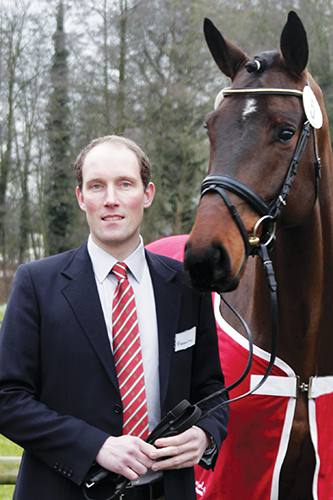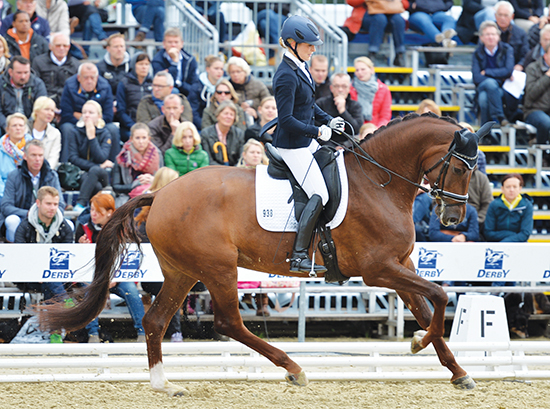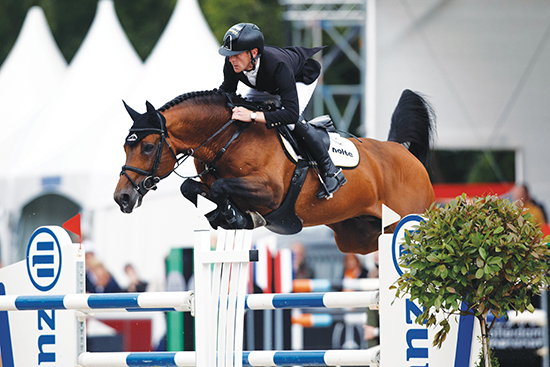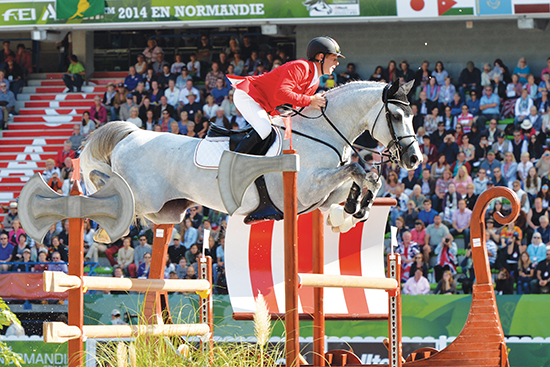 An interview with Christopher Hector & Photos by Roz Neave and Dirk Caremans
An interview with Christopher Hector & Photos by Roz Neave and Dirk Caremans
Wilken Treu is the Breeding Manager and CEO with the Westfalian Verband. I caught up with him at this year’s Bundeschampionate. He’s one of the new breed of breeding association professionals…
“I think in more than half the German Breeding associations combine the CEO and Breeding manager – in the other half the positions are separate.”
You came from another breeding association?
“I studied in Agriculture – to become a breeding manager in Germany, you have to study agriculture – and after that I worked for two years for Paul Schockemöhle at the Lewitz Stud. Since then I have been at the State Stud of Sachsen Anhalt, more jumping horse breeding – Monte Bellini comes from there. After that I came to Westfalia.”
Victoria’s Secret (Vitalis / Fidermark) and Beatrice Buchwald
Did you grow up with horses? Are your family involved with horses?
“No. It all came from my own riding – dressage – when I was young, especially in the Junior / Young rider classes. I had a very good trainer, near to Verden – close to the Hanoverians, so I got to know everything about the Hanoverian society. I learned about the breeding association and thought, I want to do something like this.”
For a long time Westfalia was just like a smaller Hanover, similar bloodlines, but now Westfalia seems to be going a little on its own…
“Westfalia opened its breeding program, twenty years ago. The breeders were able to use stallions, even from other countries, more easily than in other breeding associations. That’s why in showjumping for instance, we got Cornet Obolensky. Fortunately we have had some success with this policy, if we didn’t open our program twenty years ago, we would not have had the success we have now.”
Are you worried, particularly with your dressage horses, at the big influx of Dutch blood – looking at your last licensing, it was Dutch Dutch Dutch…
“That is already common for Westfalia. For example, much of the horse sport competition in Germany takes place in North Rhine Westfalia, so our breeders are very close to competition sport, that’s why they like to have the opportunity to choose stallions from other breeding association. They like to be a little more free in their choice, and they are not stupid, they have had success with this attitude.”
What are the qualities you think you can get from the Dutch for your dressage horses?
“Twenty, thirty years ago, it was using Thoroughbred to get the horses more light, at the moment in dressage breeding, it is a bit the same with Dutch blood. Maybe it is not right to put into every pedigree but there are some of our lines that need this blood refreshment, and the breeders have been doing it with good success. There are quite a lot of Vitalis offspring with very clear Westfalien bloodlines.”
Vitalis is a controversial stallion, he was reserve at your licensing, but was failed by the KWPN, went to America to be a sport horse, and he is now back in Germany at Mr Schockemöhle’s…
“There has been a lot of success with the young horses of Vitalis, not only the stallions but the mares too. They are quite successful in young horse classes at the moment, you see them at the breeding shows.”
When I started writing about Warmblood horses, everyone was writing about breeding the all round horse, then we had the emergence of dressage lines, jumping lines, a little bit, eventing lines, but now are we getting young horse lines – looking at the horses in the World Championship of Young Dressage Horses, in one class there was one by a Grand Prix stallion and in the other, two by Grand Prix stallions, and all the rest were by stallions that never went any further than Young Horse classes…
“Of course a lot of dressage breeders try to breed horses they can sell when they are young, this is different to the jumping breeders. The jumping breeders know that if they cannot sell the horse as a foal they need long terms riding, jumping under saddle to sell the horse – and jumping clients, they want international bloodlines. The jumping breeders are maybe a bit better in their thoughts about breeding than the dressage people in Germany.”
Comme II Faut 5 (Cornet Obolensky / Ramiro Z) and Marcus Ehning. Photo: Dirk Caremans
Are we breeding a type of horse that is very good for young horse classes, very elegant…
“But not for the last step into Grand Prix.”
Totilas is not the most beautiful modern looking type…
“That’s right, it might even become a problem because everybody tries in the end to breed a Grand Prix horse and not all the stallions are good for this – they can produce nice types of young horses, good in shape, good movement in normal trot, but if you try to work them and get them into the collection, there is a problem, these horses don’t really fit for this.”
You seem to have avoided the Sandro Hit disease in Westfalia…
“Good question, why don’t we have so much Sandro Hit. The breeders didn’t like to use him so much. We have some stallions with Sandro Hit in the third generation that they like to use now, but it is in the third generation.”
When Susanne Rimkus came to Westfalia, all the heads of the state studs, were men, but she has done a wonderful job, getting the jumping stallions out into the competition arena…
“I am happy that people realize that the State Stud in Warendorf has the best quality of jumping stallions. There is no other state stud that has this quality. In dressage we are good but of course we can have even more quality.”
What are your goals in the job?
“We have to start now to prepare our breeders for new breeding techniques, for the genomic selection. At the moment most breeders are not prepared for this and we have to start to educate them over the next two or three years, so they understand and we can start these program. Like it or not, the genomic selection will come into our breeding.”
How do you see that in practice?
“We have to start to collect the DNA of a test group, and describe these horses very completely, using the linear scoring. That is the practical work with the horses but we have to prepare the breeders so they have the knowledge. At the moment when we talk about genomic selection, they say, what is this?”
“We need to prepare our association for the new generation of breeders, the people who are coming in now. They need to be educated, and if we don’t do it, then they will do it with other breeding associations.”
Cornado NRW (Cornet Obolensky / Acrobat II) and Marcus Ehning at the European Championships
In what way do you think genomic selection is going to be better than the eye of an experienced breeder? A breeder who knows his mares and what they produce…
“Firstly, we are losing a lot of the breeders who really know the qualities of their dam lines, and know the problems they have in the dam line. We lose them because of the generational change and so we need to give the new breeders a new model. Genomic selection is not only used for breeding a Grand Prix horse, I think we have to start with health issues. In our breeding program, we don’t care enough about the health of the horse. The time you can use a horse for sport is much too short and the first step with the genomic selection, is to address these health issues. In the second step, we can use it to improve the quality of the horse, the rideabilty and the movement and jumping.”
Do you have a problem with health issues like OCD?
“The problem is no bigger than it is in the other German breeding associations. It is a problem, with the requirements the customer asks, maybe 25% of horses don’t make the grade. It is a breeding goal we have to work on.”
Will you do like the Dutch and give a breeding value for OCD to the stallions?
“That is one example – all this has to be worked out now. It is different in Holland, they have one association and they say, we do it like this. We have to reach an agreement with some of the bigger German breeding associations to implement a program like this.”
Are you going to keep a type – will people say, that is a Westfalien horse, or are we breeding a modern German sporthorse…
“From the type, we already have a modern German riding horse. If Desperados is a Hanoverian, or an Oldenburg or a Westfalien, you can’t tell – maybe that he is not a Holstein horse. But the breeding associations will keep some differences in the dam lines but not the type. For example in Westfalia we will keep the E while the Oldenburgs will have more the F line, but in general type and general quality, the horses will become equal.”
Will one day all the books, except Holstein, become one German book?
“The breeders have to decide, but what is very different in Germany from Holland, is that Germany is made up of many states with different characters – the Westfalien breeder, who really comes from Westfalia, he thinks he is a Westfalien, and wants to be treated like a Westfalien first, and the same in Hanover, or Holstein, or the Eastern Part of Germany, they are all very different and they need their own handling. They may one day be all under one roof but they need to have their special handling.”
Interested in Sport Horse Breeding – there is a whole library waiting for you right here:


